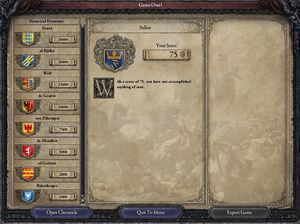![]() 分數(英文:Score)是一個衡量你的家族偉大程度的標準,通過累加你扮演的歷代角色去世時的威望和虔誠獲得。當開啟鐵人模式時,如果玩家成功達到極高的分數,可以解鎖某些Steam成就。
分數(英文:Score)是一個衡量你的家族偉大程度的標準,通過累加你扮演的歷代角色去世時的威望和虔誠獲得。當開啟鐵人模式時,如果玩家成功達到極高的分數,可以解鎖某些Steam成就。
在遊戲結束介面中,會顯示遊戲所在時期內歷史上的成功家族的假想分數:
| 分數 | 家族 | 有趣角色 | 描述 |
|---|---|---|---|
| 100 000 | 卡佩家族 | 腓力一世 卡佩 | 卡佩家族由禿頭查理的重臣強者羅貝爾所創建。他的後代在1066年獲得法蘭西王位。儘管在1322年時主支絕嗣,卡佩家族的旁系分支依然在1337年時擁有法蘭西,葡萄牙,那不勒斯,匈牙利和納瓦拉的王位。其他分支還擁有布列塔尼,勃艮第,波旁,普羅旺斯和亞該亞公爵頭銜。一個更遠的分支是君士坦丁堡拉丁帝國的皇帝。這真是中世紀歐洲史最偉大的家族。 |
| 90 000 | 哈布斯堡家族 | 維爾納 馮 哈布斯堡 | 一開始,在 1066 年,哈布斯堡家族前景十分暗淡。比起十一世紀日耳曼諸多呼風喚雨的龐大家族,哈布斯堡只是一個瑞士的小伯爵,在帝國內部無足輕重。但是一連串精心策劃的政治聯姻使家族領地不斷擴大,最終在十三世紀末十四世紀初的大混亂中被選為神聖羅馬帝國皇帝,獲得了帝國的統治權。儘管皇位並不長久,哈布斯堡還是藉機攫取了奧地利公爵頭銜。依靠奧地利,哈布斯堡家族在中歐的統治持續到了 1918 年。 |
| 80 000 | 留里克家族 | 九世紀時,來自瑞典的維京人留里克在羅斯(今天的俄羅斯和烏克蘭)建立了一個國家。在繼承人中分割領地的政策導致了國家的分裂和不同支系之間的爭鬥不休。這使他們在十三世紀時過於分裂,無法抵擋住蒙古入侵。成吉思汗之孫拔都逐個征服了這些公國,強迫他們向蒙古人納貢。不過留里克家族還是保存下來了,等待着重新崛起的時機…… | |
| 70 000 | 伊夫雷亞家族 | 伊夫雷亞家族有着傑出的祖先,但在1066年,儘管他們取得了從意大利國王到勃艮第伯爵的頭銜,卻仍然在走下坡路。看起來這個家族已經過氣了,不過一次幸運的聯姻後卡斯蒂利亞和萊昂將王冠拱手送上,使伊夫雷亞家族重新成為歐洲舞台上的關鍵角色之一。 | |
| 60 000 | 皮亞斯特家族 | 博萊斯瓦夫 「英勇者」皮雅斯特 | 皮亞斯特家族的創建者在成為波蘭國王之前據說是個輪匠。儘管波蘭王國四分五裂,皮亞斯特家族還是在這一時期穩居王位,並逐漸將波蘭變得統一而強盛。家族的其他成員包括神聖羅馬帝國的西里西亞公爵。在1337年,有史以來最偉大的國王卡齊米日三世統治着波蘭,正在秣馬厲兵準備反擊蒙古汗國。 |
| 50 000 | 科穆寧家族 | 阿萊克修斯 科穆寧 | 如果我們將1057年通過政變成為皇帝的伊薩克一世排除在外,科穆寧家族一直是拜占庭帝國的忠誠僕人。在曼奇刻爾特慘敗於塞爾柱人之後的大混亂中,科穆寧家族堅守其引以為傲的家族傳統,發動了另一場政變。在接下來的100年裡,科穆寧家族遏制住了拜占庭帝國的衰落,為帝國帶來了所謂的科穆寧復興。諷刺的是,科穆寧家族同樣被宮廷政變所推翻,不過他們在小亞細亞的特拉比松建立了新的帝國。 |
| 40 000 | House Plantagenet | House Plantagenet, who started off as a cadet branch of the elder house of Anjou. Geoffrey, the founder of the dynasty, was left with the family lands in France when his father went off to Jerusalem to become King. The Plantagenet family had a power base in France, and through marriages inherited the Kingdom of England and large parts of France. The French inheritance would lead to an ongoing conflict with France and the Hundred Years War. | |
| 30 000 | House Estrid | Svend II Estrid | House Estrid. Coming to the throne of Denmark in 1047, the house of Estrid was one of only two royal families to still hold kingdoms in 1337. Although there were several attempts at expansion, Denmark only gained small amounts of land in Estonia, as most would be gained and then lost. The dynasty itself managed to survive and prosper in an era of chaos and turmoil, which is no mean feat. |
| 20 000 | House af Bjälbo | Birger af Bjälbo | House af Bjälbo, who arguably created the modern state of Sweden. Prior to their accession the Swedish state was highly decentralised, where the writ of royal authority barely ran. The Bjälbo Kings regulated things more clearly, conquered Finland and by 1337 had entered a personal union with Norway, leading Sweden to the height of its medieval power. |
| 15 000 | House Welf | Welf I Welf | House Welf, a dynasty very much down on its luck in 1066. By 1100 that had all changed. Control of two of the most powerful duchies in Germany and substantial lands in Italy made them the second most powerful family in Germany after the Hohenstaufen. One member of the Welf family would eventually gain the title of Emperor, but in the struggles would also weaken the family and much of the lands would be lost. The family would consolidate its holdings in Northern Germany as Dukes of Brunswick and remain a player in Imperial politics. |
| 10 000 | House de Genève | Geraud de Geneve | House de Genève, who were counts of Geneva in 1066. The house held this territory throughout the period and were still counts of Geneva in 1337. They never managed to climb any higher, but at the same time were able to cling onto their holdings. |
| 7 500 | House von Zähringen | House von Zähringen, who were powerful landholders in Southern Germany and holders of the Duchies of Verona and Carinthia, which made the Zähringen family a key power holder in Germany. A failed rebellion against the Emperor saw these titles stripped from the family and other parts of the family lands would be inherited by other dynasties, leaving the family lands shrunk to a few holdings in Swabia. | |
| 5 000 | House de Montfort | Simon de Montfort | House de Montfort, who were small scale land holders in France. Through marriage and service the family gained estates in both Normandy and England. It was under the zealous but cruel Simon de Montfort the Elder that the family ascended. Through his participation in the Albigensian Crusade the family would add substantial estates in the South of France. The family reached the height of its power through his son Simon de Montfort the Younger, who became de facto ruler of England. However, all this would prove fleeting and by 1337 the family would have lost it all and gone extinct in the male line. |
| 2 000 | House of Godwin | Harold Godwinson | House of Godwin. On January 5th, 1066, Harold godwinson became King of England. His father had spent much of the reign of King Canute building up the family power base and with the death of Edward the Confessor he was able to assume the throne. However, he wasn't the only claimant... Harald of Norway and William of Normandy both also claimed the title and invaded. Harald was defeated and killed at the battle of Stamford Bridge, but Harold would later be defeated and killed (along with two of his brothers) by William at the battle of Hastings. With his death, the power of the House of Godwin collapsed and its lands were divided amongst the victorious Norman Lords who followed William. |
| 1 000 | House Babenberger | House Babenberger, which is not to be confused with the slightly more famous von Babenbergs of Austria. This cadet branch of house Capet held minor titles in Franconia. History probably wouldn't remember them if it wasn't for the more famous family with a similar name. |
